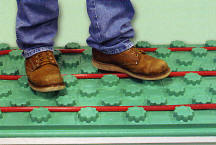

Both insulation types will start out with an R-10 insulating value for a material thickness of 2 inches, but over time the XPS foam will lose about 48% of its R-value rating while the EPS foam will only lose 6%. EPS foam has a 94% heat retention factor while XPS has a 52% retention factor. Our radiant foam insulation panels use EPS foam insulation while typical pink or blue board-type foam panels use XPS foam insulation. Applications include: basements, garages, driveways, main floor slab-on-grade, slabs over existing slabs and above-grade installations where concrete or Gypcrete is normally used. Effort-by providing a true "walk-in" installation method of simply walking the lines into the knobs, you'll save hours of back-breaking work on your knees. Money-by reducing installation labor costs and, unlike XPS foam, no additional fuel will be needed each year to maintain the same temperature.

Time-by reducing installation labor by as much as 2/3. Replacing the separate products of radiant foam, line holding grid, ties and staples, these panels greatly simplify the installation of concrete radiant floors saving you time, money and effort. It is a modular insulation board and radiant tube holding grid all-in-one product that lays right on top of the gravel or sub-floor.

Our Insulated Floor Panel Systems simplify the hydronic ra diant floor installation process. Radiant Foam Insulation Panels for Under Concrete Slabsīenefits of Insulated Floor Panel Systems Original Air Date: Jan 13, 2022, Season 43 Ep.Home > Radiant Heating Products > Radiant Floor Insulation Panels Project Designer Sam Ziergiebel talks about the role of both. The inverter and battery backup have been installed in the basement for the system. Solar expert Tim Sandborn accomplishes this by using all-black, high-efficiency, and aesthetically pleasing panels. Homeowners Megan and Lincoln wanted solar but did not want the panels visible. Guided by company President Elizabeth Sheffield, Kevin gets a behind-the-scenes-of-the-making process.īack in Concord, solar panels are being installed. Then, Kevin visits a company in Reading, PA, that started the same year our Cape was built making cast iron coal stoves but has since evolved to making restaurant-quality ranges and hoods for the home chef. Insulation Consultant Adam Piccirilli talks about the new environmentally friendly spray foam insulation required in most states. Charlie shares his trick that allows the insulation to perform optimally and prevent thermal bridging. He uses an unconventional zoning method, radiant floor heating, and a small duct high-velocity system.
#Crete heat panels how to#
Richard Trethewey talks about how to best heat the home, which is difficult because of its unconventional layout and minimal wall space.

#Crete heat panels install#
The three install a moisture-resistant composite decking material with the ease of a hidden fastener clip system and back-friendly tools.īecause the basement will be a living space, they take extra measures to insulate the space correctly. Outside in 30-degree weather, Kevin O’Connor joins Tom and Charlie Silva on the soon-to-be top deck, where they installed rubber membrane and sleepers in preparation for the new deck. Now that electrical, plumbing, and HVAC are completed behind the walls. Work at our 1880 Cape continues as the temperature drops.


 0 kommentar(er)
0 kommentar(er)
